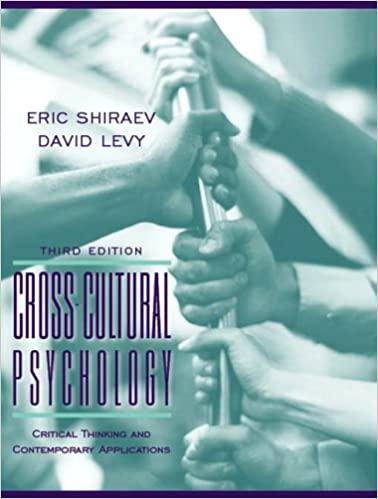Question
Domjan, M. (2014). The principles of learning and behavior . Nelson Education (p. 343-363) ------------------------------------------------------------------------------------------------------------------------------- Explain the relevance of timing with respect to behavior. Do
Domjan, M. (2014).The principles of learning and behavior. Nelson Education (p. 343-363)
-------------------------------------------------------------------------------------------------------------------------------
- Explain the relevance of timing with respect to behavior. Do you think that theories of timing emphasize cognitive constructs over behavioral constructs?
2. Provide 5 examples of time-dependent effects.
3. List some of the techniques for studying temporal control of behavior.
4. What is the difference between duration estimation and peak procedure? Provide an example.
5. Define scalar invariance.
6. Compare the scalar expectancy theory and behavioral theory of timing. How do they differ? What are the strengths and weaknesses of each theory?
7. What is the difference between response chain, paired associated learning and serial-representation learning? Provide an example of each.
8. Why adjunctive behavior provides a model to explain timing?
9. Define serial order performance. Give an example.
10. Describe simultaneous chain procedure. Give an example.
______________________________________________________________________________
Lejeune, H., Richelle, M., & Wearden, J. H. (2006). About Skinner and Time: BehaviorAnalytic Contributions to Research on Animal Timing. Journal of the Experimental Analysis of Behavior, 85(1),125-142.
-------------------------------------------------------------------------------------------------------------------------------
- What are the two major contributions of Skinner's work? Explain
- List some of the precursors of behavioral models of timing, as mentioned by Lejeune et al (2006).
3. Describe some of the schedule of reinforcement to study timing?
______________________________________________________________________________
Fayolle, S., Gil, S., & Droit-Volet, S. (2015). Fear and time: Fear speeds up the internal clock. Behavioural Processes, 120, 135-140.
-------------------------------------------------------------------------------------------------------------------------------
- Why the authors evaluate the effects of emotion using the Scalar Expectancy Theory?
2. How does the research being reported in this paper fill gaps inour knowledge/ or understanding of this topic/phenomenon?
3. How the procedure was implemented in this study?
4. What were the main findings/results in this study? What the authors found?
5. How the results relate to the prediction/hypotheses set out in the introduction (i.e., are they supported or not)?
Step by Step Solution
There are 3 Steps involved in it
Step: 1

Get Instant Access to Expert-Tailored Solutions
See step-by-step solutions with expert insights and AI powered tools for academic success
Step: 2

Step: 3

Ace Your Homework with AI
Get the answers you need in no time with our AI-driven, step-by-step assistance
Get Started


